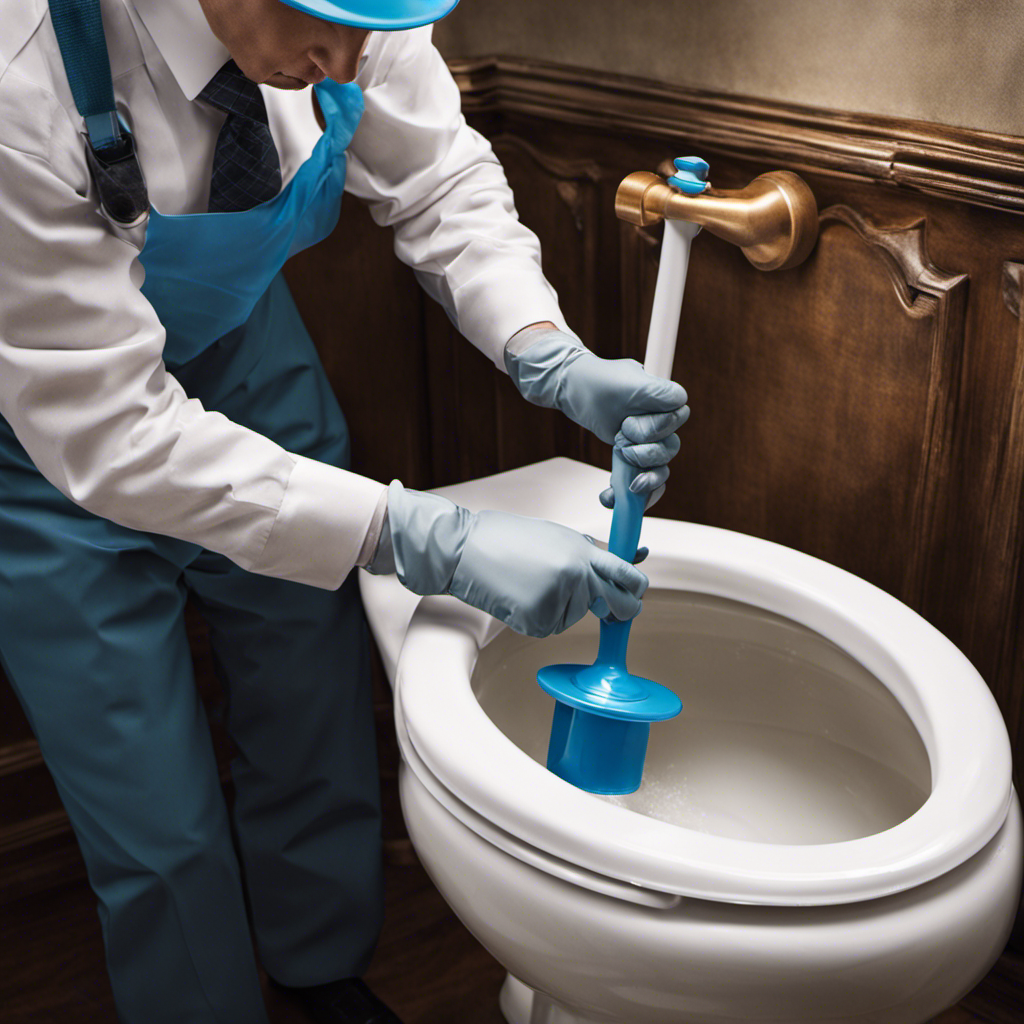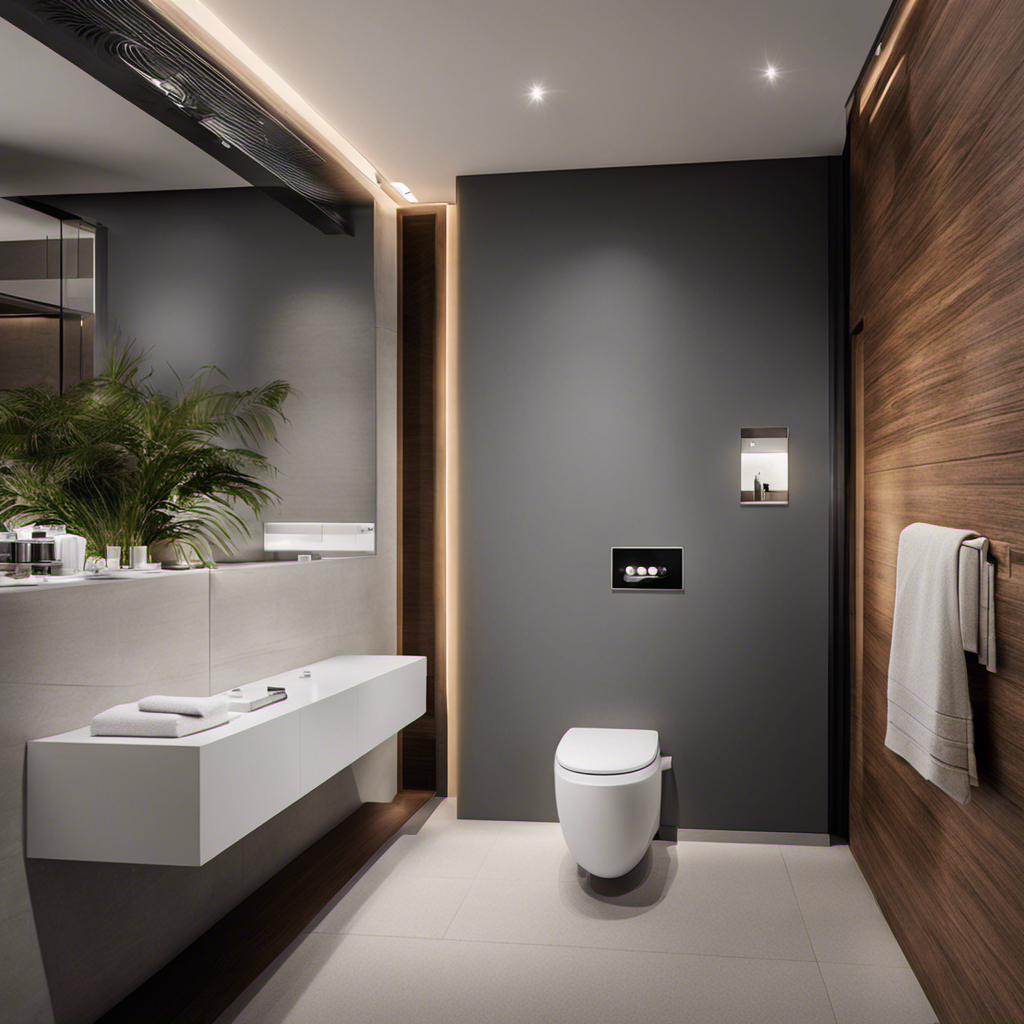I’ve been there – standing in front of a clogged toilet, feeling frustrated and unsure of what to do next. But fear not! With the right tool in hand, you can tackle this problem yourself.
In this article, I’ll guide you through the step-by-step process of using a toilet auger. From selecting the right one to troubleshooting common issues, I’ll provide you with all the information you need to become a toilet-clog conqueror.
So let’s get started and unclog that toilet once and for all!
Key Takeaways
- Consider the length and flexibility of the cable when selecting a toilet auger.
- Choose a manual auger for small clogs and a power auger for larger clogs.
- Ensure the auger is suitable for the specific type of toilet and clog.
- Regularly maintain and troubleshoot the auger for optimal performance.
Selecting the Right Toilet Auger
When selecting the right toilet auger, it’s important to consider the length and flexibility of the cable. The length of the cable determines how far it can reach into the toilet drain, so you need to choose one that is long enough to reach the clog.
It’s also crucial to understand the different types of augers available. There are manual augers, which require physical effort to operate, and power augers, which use an electric motor to rotate the cable. Manual augers are suitable for small clogs, while power augers are better for larger, more stubborn clogs.
Additionally, you should look for an auger with a flexible cable that can navigate through the twists and turns of the toilet drain without getting stuck.
Understanding the Components of a Toilet Auger
When it comes to understanding the components of a toilet auger, it’s important to have a clear understanding of its anatomy.
Auger anatomy is essential in order to effectively use and maintain this plumbing tool.
Auger Anatomy Explained
To understand how a toilet auger works, you need to know the anatomy of the tool. Here are some key points to help you grasp the concept:
-
The handle: This is where you hold the auger, providing you with a firm grip and control over the tool.
-
The cable: It is a long, flexible coil that extends from the handle to the clog. The cable is inserted into the toilet drain to break up obstructions.
-
The crank: Attached to the handle, the crank allows you to rotate the cable in a clockwise motion, helping it navigate through the pipes.
-
The bulb or corkscrew: This is the end of the cable that does the actual work. Its shape allows it to catch onto and break up the clog.
Understanding the different components of a toilet auger is essential for proper toilet auger maintenance and troubleshooting clogged toilets.
Now, let’s dive deeper into the key auger components.
Key Auger Components
Take a closer look at the key components of an auger so you can understand how it works.
The main feature of an auger is the long, flexible shaft made of steel or plastic. This shaft is inserted into the drain pipe to clear clogs.
At the end of the shaft, there is a rotating drum or coil that is used to break up the blockage. The drum or coil is connected to a handle, which allows you to turn it and apply force.
When using an auger, it is important to keep the shaft straight to prevent it from getting stuck. If the auger gets stuck, you can try rotating it in the opposite direction or applying gentle pressure to dislodge the clog.
Remember to always wear gloves and goggles when using an auger to protect yourself from any splashes or debris.
Understanding Auger Parts
The main feature of an auger is a long, flexible shaft inserted into the drain pipe. This shaft is connected to a handle that allows for easy manipulation and control. Augers come in different sizes and designs, but they all serve the same purpose of clearing clogs in the toilet.
To ensure the proper functioning of your auger, regular maintenance is necessary. This includes cleaning the shaft and handle, lubricating moving parts, and inspecting for any damage or wear. Troubleshooting techniques can also be employed if the auger is not working properly, such as checking for blockages in the shaft, adjusting the handle, or clearing any debris from the toilet bowl.
By properly maintaining and troubleshooting your auger, you can ensure its effectiveness in clearing clogs and keeping your toilet in good working condition.
Now, let’s move on to preparing the toilet for auger use.
Preparing the Toilet for Auger Use
First, make sure you’ve turned off the water supply to the toilet before using the auger. This is an important step to prevent any water from overflowing while using the tool. Now, let’s talk about the different types of toilet augers available in the market.
| Type of Toilet Auger | Description | Best Use |
|---|---|---|
| Closet Auger | Designed for clearing clogs in the toilet’s trap | Ideal for basic clogs |
| Handheld Auger | Manual auger with a crank handle | Suitable for small clogs |
| Power Auger | Electric auger with a motor for more power | Used for stubborn clogs |
Now that you have an understanding of the types, let’s discuss the steps for using a toilet auger:
- Insert the auger into the toilet bowl, ensuring it goes into the drain.
- Rotate the auger clockwise to break up the clog.
- Continue rotating until the auger breaks through the clog.
- Slowly retract the auger, being cautious not to scratch the toilet bowl.
Using the Toilet Auger Properly
Now that we’ve prepared the toilet for auger use, let’s dive into using the toilet auger properly. It’s important to follow the right steps and techniques to avoid any mishaps or further damage. Here’s how:
- Insert the auger cable into the toilet bowl, making sure it goes down the drain.
- Begin rotating the handle clockwise while applying gentle pressure.
- Continue feeding the cable into the drain until you feel resistance.
- Once you’ve reached the clog, rotate the handle back and forth to break it up and clear the blockage.
To ensure the longevity of your toilet auger and troubleshoot any potential problems, regular maintenance is key. Clean the auger cable after each use, inspect for any signs of damage or wear, and lubricate moving parts as needed. If you encounter any issues, such as the auger getting stuck or not clearing the clog, consult the manufacturer’s instructions or seek professional assistance.
Troubleshooting Common Issues With Toilet Auger
When it comes to dealing with clogged toilet drains, it’s important to use proper auger techniques to effectively unclog the pipes.
Using a toilet auger can be a highly effective tool, but it’s crucial to use it correctly to avoid causing any damage to the pipes.
Clogged Toilet Drains
To unclog your toilet drain, grab the toilet auger and insert it into the toilet bowl. This versatile tool is designed specifically for clearing blockages in the toilet. Here are some unclogging techniques to help you get the job done:
- Start by cranking the auger handle clockwise to extend the cable.
- Once the auger is inserted, push it gently but firmly into the drain.
- Rotate the auger handle counterclockwise to break up the clog.
- Continue pushing and rotating the auger until you feel the resistance ease.
Common causes of clogged toilets include excessive toilet paper, foreign objects, and a build-up of waste and debris. It’s important to avoid flushing items that are not meant to be disposed of in the toilet, such as sanitary products or baby wipes.
Regular maintenance and proper use of the toilet can help prevent clogs and keep your bathroom functioning smoothly.
Proper Auger Techniques
The first step in properly using an auger is to extend the cable by cranking the handle clockwise. This ensures that the cable is fully extended and ready for use.
Once the cable is extended, I place the auger into the toilet bowl, making sure to guide it gently down the drain. It’s important to avoid using excessive force, as this can lead to damage or injuries.
I then start rotating the handle counterclockwise, slowly and steadily. This motion helps the auger to break up the clog and clear the drain.
Throughout the process, I remain cautious and attentive, ensuring that I am using the proper technique to avoid any injuries.
Avoiding Pipe Damage
Be cautious and gentle when extending the cable with the handle, as excessive force can result in damage to the pipes. To ensure proper pipe maintenance and prevent clogs, follow these tips:
- Start by slowly inserting the auger into the toilet bowl, making sure it goes down smoothly.
- Rotate the handle clockwise to extend the cable deeper into the pipes, but avoid forcing it if you encounter resistance.
- If you feel a blockage, gently maneuver the auger back and forth, allowing the cable to break through the clog without causing harm.
- Once the clog is cleared, slowly retract the auger, making sure to clean the cable thoroughly before storing it.
By following these steps, you can effectively use a toilet auger while minimizing the risk of damaging your pipes.
Regular maintenance and preventive measures like using a plunger or drain screens can also help prevent future clogs.
Maintaining and Storing Your Toilet Auger
Storing your toilet auger properly will help maintain its functionality. To ensure that your auger stays in good condition, there are a few key maintaining techniques to keep in mind.
After each use, make sure to clean the auger thoroughly, removing any debris or residue. This will prevent any buildup that could affect its performance. Additionally, inspect the auger regularly for any signs of damage or wear, such as bent or dull blades. If you notice any issues, it’s important to address them promptly to avoid further damage.
When it comes to proper storage, find a designated spot for your auger that is dry and away from any moisture or extreme temperatures. Keep it in a secure place where it won’t get knocked around or damaged.
Frequently Asked Questions
Can a Toilet Auger Be Used to Unclog Sinks or Other Drains?
No, a toilet auger is specifically designed for unclogging toilets and may not be effective for unclogging sinks or other drains. There are alternative drain unclogging methods that are more suitable for these situations.
How Often Should I Use a Toilet Auger to Prevent Clogs?
To prevent clogs, I use a toilet auger regularly. It’s like a superhero that fights against blockages. By doing preventive maintenance and watching for signs of a clogged toilet, I keep things flowing smoothly.
Is It Safe to Use a Toilet Auger if My Toilet Is Already Overflowing?
If your toilet is already overflowing, using a toilet auger may not be safe. It’s important to troubleshoot the issue first and try using a plunger. If the problem persists, then consider using a toilet auger.
Can a Toilet Auger Damage the Porcelain Bowl of My Toilet?
Using a toilet auger can potentially damage the porcelain bowl of your toilet if not used properly. To prevent this, it is crucial to follow proper toilet auger maintenance and choose the right auger for your toilet.
Can I Use a Toilet Auger if I Have a Septic System?
Using a toilet auger with a septic system can cause major damage and lead to costly repairs. It’s important to prioritize septic system maintenance and explore alternative methods like enzymatic cleaners or professional plumbing services.
Conclusion
In conclusion, using a toilet auger can be a simple and effective solution for unclogging toilets. By following the steps outlined in this article, you can successfully use a toilet auger to clear any blockages.
One interesting statistic to note is that according to a study by the Consumer Product Safety Commission, toilet clogs account for nearly 5% of all residential plumbing issues. This emphasizes the importance of knowing how to properly use a toilet auger to avoid costly repairs and inconvenience.
Remember to always maintain and store your toilet auger properly for future use.










